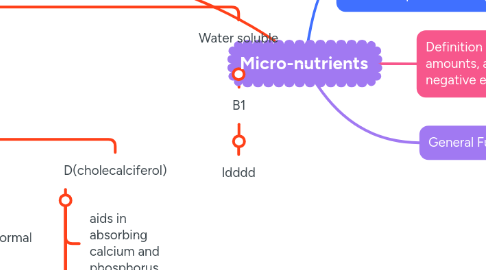
1. Types of vitamins
1.1. Fat soluble=can be stored in fat tissues in the body
1.1.1. A(retionol)
1.1.1.1. Form pigments in eye retina , to form and maintain healthy skin, proides resisance to infections , growth and development, antioxidant
1.1.1.2. Liver,milk,fish oils, egg yolk, beta carotene ( found in red yellow and orange coloure fruits and vegetables
1.1.1.3. Toxicity=fatigue, painful joins , birth defects in babies , nausea and diarrhea,liver and nervous system
1.1.2. E
1.1.2.1. Toxicity=may decrease the absorption on vitamin in the body
1.1.2.1.1. Deficiencies=Haemolysis(, anaemia, nerve disease
1.1.3. K
1.1.3.1. Function=normal blood clotting
1.1.3.1.1. sources=liver, vegetable oils, legumes, green leafy vegetables, produced by the bacteria in large intestine
1.1.3.1.2. Lack of it=excessive bleeding of wounds ( blood not able to clot properly)
1.1.3.1.3. Toxicity= Rare
1.1.4. D(cholecalciferol)
1.1.4.1. aids in absorbing calcium and phosphorus
1.1.4.2. Deficiencies=weak bone and teeth, rickets
1.1.4.3. Sources=oily fish, milk, liver fish, egg yolk, cheese, sunlight
1.1.4.4. Toxicity=causes hypercalcemia, increase level pf calcium in blood, hardening of arteries and organs such as liver and kidneys
1.2. Water soluble
1.2.1. B1
1.2.1.1. ldddd
